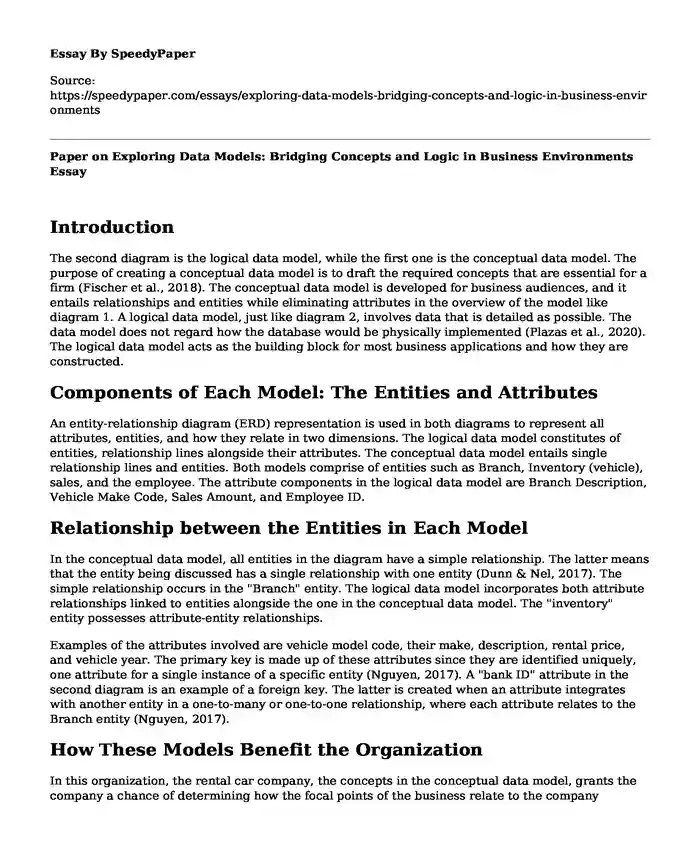
| Type of paper: | Essay |
| Categories: | Company Management Business |
| Pages: | 4 |
| Wordcount: | 925 words |
Introduction
The second diagram is the logical data model, while the first one is the conceptual data model. The purpose of creating a conceptual data model is to draft the required concepts that are essential for a firm (Fischer et al., 2018). The conceptual data model is developed for business audiences, and it entails relationships and entities while eliminating attributes in the overview of the model like diagram 1. A logical data model, just like diagram 2, involves data that is detailed as possible. The data model does not regard how the database would be physically implemented (Plazas et al., 2020). The logical data model acts as the building block for most business applications and how they are constructed.
Components of Each Model: The Entities and Attributes
An entity-relationship diagram (ERD) representation is used in both diagrams to represent all attributes, entities, and how they relate in two dimensions. The logical data model constitutes of entities, relationship lines alongside their attributes. The conceptual data model entails single relationship lines and entities. Both models comprise of entities such as Branch, Inventory (vehicle), sales, and the employee. The attribute components in the logical data model are Branch Description, Vehicle Make Code, Sales Amount, and Employee ID.Relationship between the Entities in Each Model
In the conceptual data model, all entities in the diagram have a simple relationship. The latter means that the entity being discussed has a single relationship with one entity (Dunn & Nel, 2017). The simple relationship occurs in the "Branch" entity. The logical data model incorporates both attribute relationships linked to entities alongside the one in the conceptual data model. The "inventory" entity possesses attribute-entity relationships.
Examples of the attributes involved are vehicle model code, their make, description, rental price, and vehicle year. The primary key is made up of these attributes since they are identified uniquely, one attribute for a single instance of a specific entity (Nguyen, 2017). A "bank ID" attribute in the second diagram is an example of a foreign key. The latter is created when an attribute integrates with another entity in a one-to-many or one-to-one relationship, where each attribute relates to the Branch entity (Nguyen, 2017).
How These Models Benefit the Organization
In this organization, the rental car company, the concepts in the conceptual data model, grants the company a chance of determining how the focal points of the business relate to the company (Kashmira & Sumathipala, 2018). In the conceptual data model, each vital factor of the company is allowed to relate to a particular location of the company's branch. By drawing the concepts, it will enable the company to reexamine their processes oriented to the business per the relationships generated by the data model.
Even though the logical data model implements the plan laid by the conceptual data model and assigns entities their respective attributes, the latter are essential data characteristics since they integrate with a specific entity (Henriques & O'Neill, 2020). Based on the situation of the rental car company, the central entity is the branch entity. The branch entity relates to all the external entities (Santos & Costa, 2016). If the sales entity were chosen as the central entity, it would be ineffective; it would be expected to refer to the branch entity.
How Would These Models Be Useful
The models would be useful to build a database since they initiate the SDLC (Shin et al., 2017). A physical data model is constructed after the logical model is approved. The physical model depicts the structure viable to be followed in the implementation of a database. Also, the physical model allows us to define the characteristics of DBMS, making the model technology dependent. The data modeling processes or both logical and conceptual models are essential to further the creation of a database alongside developing a physical data model
References
Dunn, C., & Nel, L. D. (2017). Entity relationship diagram mapping. http://people.scs.carleton.ca/~ldnel/recent_honours_projects/ERMapper-Cheryl%20Dunn.pdf
Fischer, P. M., Deshmukh, M., Maiwald, V., Quantius, D., Gomez, A. M., & Gerndt, A. (2018). Conceptual data model: A foundation for successful concurrent engineering. Concurrent Engineering, 26(1), 55-76. https://journals.sagepub.com/doi/abs/10.1177/1063293X17734592
Henriques, T. A., & O'Neill, H. (2020). Action, design & research-a logical data model. In ECIS. https://aisel.aisnet.org/cgi/viewcontent.cgi?article=1034&context=ecis2020_rp
Kashmira, P. G. T. H., & Sumathipala, S. (2018, December). Generating entity relationship diagram from requirement specification based on NLP. In 2018 3rd International Conference on Information Technology Research (ICITR) (pp. 1-4). IEEE. https://ieeexplore.ieee.org/abstract/document/8736146/?casa_token=Yn0yvpjL72EAAAAA:MwyPMW-tcXzGCWQMw3Zjkt_LriXLlnA7jZA53BB7BIcpJUPvYSuWmOzPiHVMn7SP8ehwJxfGEeuSVw
Nguyen, D. Q. (2017). An overview of embedding models of entities and relationships for knowledge base completion. arXiv preprint arXiv:1703.08098. https://arxiv.org/abs/1703.08098
Plazas, J. E., Bimonte, S., de Vaulx, C., Schneider, M., Nguyen, Q. D., Chanet, J. P., ... & Corrales, J. C. (2020). A Conceptual data model and its automatic implementation for IoT-Based business intelligence applications. IEEE Internet of Things Journal. https://ieeexplore.ieee.org/abstract/document/9166571/?casa_token=g7QWISoJu5UAAAAA:_kXMOxeZobl42yZ1EITbCDj-2q9mAEofL9xTgXfno53jI9uqbXnMujycRPXcIephfrV_VAoGzBDupg
Santos, M. Y., & Costa, C. (2016, June). Data models in NoSQL databases for big data contexts. In International Conference on Data Mining and Big Data (pp. 475-485). Springer, Cham. https://link.springer.com/chapter/10.1007/978-3-319-40973-3_48
Shin, K., Hwang, C., & Jung, H. (2017). NoSQL database design using UML conceptual data model based on Peter Chen's framework. International Journal of Applied Engineering Research, 12(5), 632-636. https://www.ripublication.com/ijaer17/ijaerv12n5_12.pdf
Cite this page
Paper on Exploring Data Models: Bridging Concepts and Logic in Business Environments. (2023, Dec 27). Retrieved from https://speedypaper.net/essays/exploring-data-models-bridging-concepts-and-logic-in-business-environments
Request Removal
If you are the original author of this essay and no longer wish to have it published on the SpeedyPaper website, please click below to request its removal:
- Marketing Essay Example: LA BOUQUE Brand Research
- Essay Example: Description of Tesla's Industrial Sector and Sub-sector
- Infosoft - Business Plan Essay Sample
- Essay Example about Wal-Mart in the Global Market
- Paper Example on Scottish Airlines Branding Plan
- Essay Sample on Expanding a Business Model
- Essay Example on Uber Company's Unethical Practices
Popular categories




